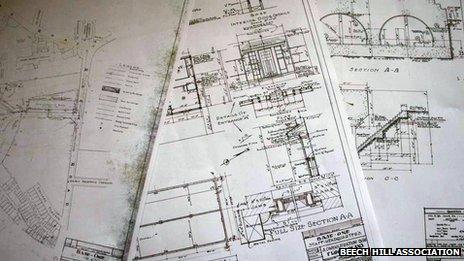Magee College's secret Battle of the Atlantic bunker
- Published

The layout plans for Base One Europe, the US Naval Operational Base Londonderry in 1942
A bunker now hidden under the lush lawns of Magee College may have been one of three allied command centres during the Battle of the Atlantic.
During World War II, the Royal Navy was headquartered at Magee College, now the University of Ulster's north west campus.
Londonderry's wartime role was recalled in May as hundreds of servicemen and women attended commemorations marking 70 years since a turning point in the battle of the Atlantic was reached.
The battle was the longest continuous military campaign of WW II. It was fought for the control of vital supply routes, beginning as war broke out in 1939.
The Derry naval base was used by the Royal Navy, the Royal Canadian Navy and the United States Navy and was vital to the protection of convoys in the Atlantic.
Mark Lusby, from the Walled City Heritage Trust, says the recent commemorations meant people were "naturally curious" to see what archaeological evidence there is for Derry's strategic role in the battle. During his research Mark discovered documents showing the college's wartime role.
"What we've got here, we believe for the first time ever, is an accurate record of what the layout was here in Magee 70 years ago in 1942," he said.
"These are the layout plans for Base One Europe which is the US Naval Operational Base Londonderry in 1942. What it shows is the headquarter buildings plus shelters - subterranean structures on the current Magee campus.
"It was a two-storey building, but interestingly the second storey was underground so it appeared very much as just a single storey prefab building above ground."
The existence of the underground bunker would have been kept secret to prevent the knowledge of its existence from falling into enemy hands.
Mark is also interested in another building marked on the map as a shelter and located where some of the modern buildings in Magee now stand.
"The more detailed plans show it was designed as a bomb-proof mapping and control room and that it wasn't just an ordinary shelter," he said.
"This was highly defended with gas protection chambers."
'Distinctiveness'
Professor Robert Gavin, former provost of Magee, says the rediscovered plans and photographs shed new light on information he had been given in the 1980s.
"If I had seen these plans and photographs when we were going to undertake the construction of the development here it would have made things much simpler," he said.
"Because initially the idea was to undertake the development of everything you now see - the red brick buildings - that was to be placed in front of the Gothic main building."
Professor Gavin said the college's handyman John Cook had asked him if test drillings on the proposed site had come back clear.
According to Professor Gavin, Mr Cook recommended the developers should do some more tests.
"He said he tumbled some buildings there at the end of the war. There was a whole underground complex here. On the surface there were just wooden buildings, they knocked those down but underneath there was a whole lot of rubble.
"Now I've seen Mark's photographs I can see what was put in there because he has photographs of them actually constructing the buildings.
Mark Lusby said that while a lot of the archaeology may have been removed in the redevelopment of Magee, "it's really important that students coming here know the history of this place".
"When they have their cappuccino in the bunker cafe, if we now can show them maps, if we can show them photographs of the people who were here before, it gives this campus a bit of distinctiveness and a bit of history that the Jordanstown and other campuses lack," he said.
"So it's important for future generations that we fill in these details to bring this place to life."
- Published12 May 2013
- Published10 May 2013
- Published8 May 2013